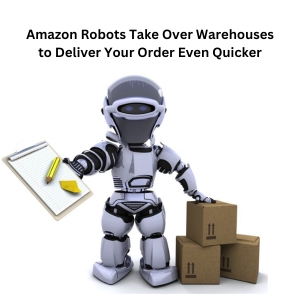Amazon Robots Take Over Warehouses to Deliver Your Order Even QuickerPosted by Atul on October 19th, 2023  Amazon Warehouses to Deliver Your Order Even QuickerAmazon's warehouses and their use of robots to make the order delivery process even faster for their customers.Amazon has been investing heavily in automation and robotics technology for their warehouses. These robots are designed to help with sorting and delivering packages, making the entire process more efficient and streamlined. We all know Amazon as a giant online retailer that provides a wide range of products at our fingertips. With millions of orders being placed every day, it's no surprise that they are constantly looking for ways to improve their operations and provide the best service possible. One might wonder why Amazon feels the need to introduce robots into their warehouses when they already have human workers doing these tasks. The answer lies in their commitment to providing fast delivery times for customers. The use of robots in warehouses not only increases efficiency but also helps reduce errors and increase accuracy. These machines are equipped with advanced sensors and algorithms that allow them to move around without colliding with each other or any obstacles in their path. What are Amazon Robots?So, what exactly are Amazon robots? In simple terms, they are automated machines that help with order fulfillment in Amazon warehouses. They work alongside human employees, making their jobs easier and faster. These robots are equipped with advanced technology that allows them to navigate through the warehouse and pick up orders efficiently. There are different types of Amazon robots used in warehouses, but one stands out Kiva robots (now known as Amazon Robotics). These orange colored robots have revolutionized the way items are stored, picked, and packed in Amazon warehouses. Before Kiva robots were introduced, employees had to walk through aisles of shelves to find products and bring them back to a central packing area. But now, thanks to Kiva robots, items come directly to the employees at designated packing stations. Each robot is assigned a specific task based on its location in the warehouse map. The robot locates its target shelf, picks up the entire shelf using suction cups, and brings it back to an employee who then takes out the required item for packing. The use of Kiva robots has significantly increased efficiency and speed in order fulfillment at Amazon warehouses. With these robots working alongside human employees, orders can be processed at a much faster rate than before. Benefits of Using Amazon Robots for Warehouse OperationsWelcome to the world of automation! With technology constantly evolving and improving, it's no surprise that even warehouses are becoming more efficient and productive with the help of robots. Yes, you read that right Amazon robots are taking over warehouses to deliver your orders even quicker. Increased Efficiency and Speed:When it comes to fulfilling orders, time is of the essence. With Amazon robots in warehouses, the whole process has become much faster and more efficient. These robots are equipped with advanced sensors and cameras that help them navigate through the warehouse quickly, without any human intervention. Imagine a traditional scenario where workers have to manually search for items in a huge warehouse to fulfill an order. This can be a tedious and time consuming task, leading to delays in order fulfillment. Cost Savings:Implementing Amazon robots in warehouses also leads to cost savings for companies. The initial investment may seem high, but in the long run, it proves to be cost effective. With robots working round the clock, there is no need for additional human labor during peak seasons or overtime pay. Moreover, since these robots can navigate through tight spaces in warehouses and shelves at heights that may not be safe for humans, there is no need for expensive modifications or safety equipment. This results in significant cost savings for companies. How Do Robots Work? - Overview of the technological capabilities and functionsHave you ever wondered how your online orders get picked, packed, and shipped so quickly? Well, the answer lies in the advanced technology of robots that have taken over warehouses to make fulfillment faster and more efficient than ever before. Automated Fulfillment:One of the key benefits of using robots in warehouse operations is their ability to work in tandem with human workers. These robots are designed to assist humans in fulfilling orders by taking on the mundane and repetitive tasks. This not only saves time but also allows human workers to focus on more complex tasks that require critical thinking and problem solving skills. Navigation Systems:To make their way through the warehouse aisles and avoid obstacles, these robots rely on highly advanced navigation systems. They are equipped with sensors that enable them to map out their surroundings and make decisions based on the data they collect. These sensors allow them to detect potential obstacles in their path, such as shelves or other equipment, and safely navigate around them. Machine Learning:Robots are not just limited to following set instructions; they have the ability to learn from their surroundings and adapt accordingly. This is made possible by machine learning algorithms that continuously analyze data from the warehouse environment and make adjustments for maximum efficiency. Impact on Warehouse EmployeesOne of the major changes that come with the incorporation of robots in warehouse operations is the shift in job roles and responsibilities for human workers. With machines handling routine tasks such as packaging and sorting, human employees can focus on more complex tasks such as quality control and inventory management. However, this also raises concerns about potential displacement of human workers due to technological advancements. As robots become more advanced and capable of handling more tasks, there is a fear that many jobs may become obsolete. To address these concerns, companies like Amazon are working towards creating a collaborative work environment where humans work alongside robots instead of being replaced by them. This means that employees will still have important roles to play in the warehouse, but their job duties might change as they adapt to working alongside machines. In order to successfully implement this collaborative system, companies are investing in training programs for their employees. These programs aim to equip workers with the necessary skills and knowledge to work efficiently alongside robots. They may include learning how to operate and maintain these machines or understanding how they can complement each other's strengths. Expansion Plans for Robot Use at Amazon WarehousesIt's no secret that Amazon has been at the forefront of using technology to improve their business operations. The company has been utilizing robots in their warehouses since 2012, with over 200,000 machines currently in use. These robots are designed to move shelves of products around the warehouse, making it easier for human workers to locate and retrieve items for order fulfillment. With the introduction of new generation robots, Amazon is taking it up a notch. These advanced machines have the ability to pick up and sort items without human assistance. This means faster processing times and ultimately quicker delivery of orders to customers. But what does this mean for human workers? Will they be replaced by robots? The answer is no. Amazon has made it clear that their goal is not to replace humans with robots but rather to work alongside them and enhance their capabilities. As Jeff Wilke, CEO of Worldwide Consumer at Amazon, stated in a recent press release: "We're not looking to automate people out of jobs; we're looking to automate tasks that are repetitive and dull." In fact, as the company expands its use of robots, there will also be an increase in job opportunities for humans. With more warehouses adopting this technology, there will be a need for technicians and engineers to maintain and repair these machines. Future Possibilities With Amazon RobotsThe implementation of robots in warehouse operations is no longer a concept of the future it is happening right now. Companies are recognizing the benefits of using robots for tasks such as sorting, picking, and packing. And Amazon is leading the way with over 200,000 robots currently operating in their warehouses worldwide. This number is expected to double over the next few years. So what could be next for Amazon robots? One possibility is expanding their use beyond just warehouse operations. With drones already being tested for delivery purposes, it's not far-fetched to imagine a future where robots are also utilized for this task. Imagine receiving your order within hours instead of days all thanks to an efficient team of robots working tirelessly behind the scenes. Of course, with any technological advancement comes concerns about job displacement and safety issues. Many workers fear that these robots will replace human jobs, leading to unemployment. However, according to Amazon's CEO Jeff Bezos, these worries are unfounded as he believes that more jobs will be created due to increased demand and growth in operations. Moreover, companies like Amazon are taking measures to ensure workplace safety when integrating robots into their warehouses. Check Out:Like it? Share it!More by this author |


